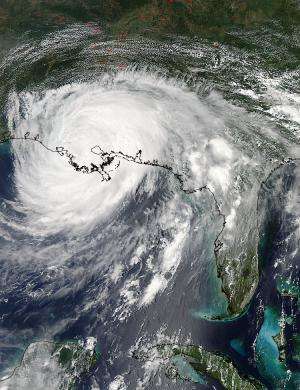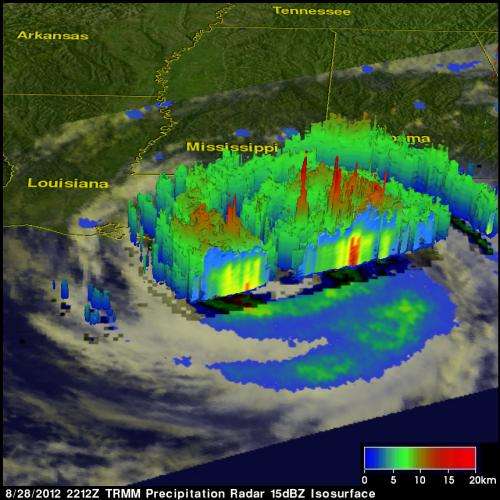NASA watching Tropical Storm Isaac drench US Gulf Coast region and lower Mississippi River Valley

NASA satellites are providing forecasters with data on rainfall rates within Tropical Storm Isaac as it continues to track over Louisiana, Mississippi and spread northward into the lower Mississippi Valley. Isaac has a large supply of rain, drawing its power from the warm waters of the Gulf of Mexico. NASA's TRMM satellite revealed that some areas within Isaac were dropping rainfall at a rate of 2.75 inches per hour.
The Tropical Rainfall Measuring Mission (TRMM) satellite twice flew directly above Hurricane Isaac as it was starting to pound Louisiana with strong winds and heavy rainfall. TRMM is a joint mission between NASA and the Japanese space agency JAXA.
NASA Measures Isaac's Heavy Rainfall Rates
TRMM's first orbit was on August 28, 2012 at 2212 UTC (5:12 p.m. CDT) and the second time was on August 29, 2012 at 0307 UTC (August 28, 2012 at 10:07 p.m. CDT). Isaac had just made landfall over the Mississippi delta when data used in the first image was captured and was making another Louisiana landfall at the time TRMM flew over Isaac again. An analysis of rainfall done at NASA's Goddard Space Flight Center in Greenbelt, Md. using data from TRMM's Microwave Imager (TMI) and Precipitation Radar (PR) instruments showed that intense bands of rain around Isaac were occasionally dropping rain at a rate of over 70 mm/hour (~2.75 inches).
Due to Isaac's slow movement and intense rainfall, the National Hurricane Center (NHC) expects a prolonged period of flooding in the affected area. The NHC expects Isaac to produce total rainfall amounts of 7 to 14 inches with possible isolated maximum amounts of 25 inches over much of Louisiana., Mississippi, southwest Alabama, and Arkansas through Friday, Aug. 30.
Storm Surges Happening on Aug. 30
According to gauges from the National Ocean Service on Aug. 30 at 8.a.m EDT at New Canal Station, Louisiana a storm surge of near 6 feet was still occurring on the southern shore of Lake Pontchartrain and a storm surge near 5 feet was occurring at Waveland, Mississippi.
Isaac in 3-D Shows Powerful, Towering Thunderstorms
A three-dimensional view of rainfall within then Hurricane Isaac was made at NASA Goddard using TRMM's Precipitation Radar (PR) data. The 3-D image showed a few very powerful thunderstorms near Isaac's eye were reaching heights of almost 17km (~10.6 miles). Those tall thunderstorms near a hurricane's center release heat and can help a hurricane become more powerful. NHC reported at 10 p.m. CDT (close to the time of the first TRMM image) that Isaac's central pressure had fallen to its lowest value of 968 millibars (~28.58 inches of mercury).

Landfall on Hurricane Katrina's Anniversary
Seven years ago on Aug. 29 Hurricane Katrina made landfall in southeastern Louisiana in nearly the same location as did Isaac in 2012. Katrina of course brought a massive storm surge that inundated large portions of the northern Gulf coast, reaching almost 28 feet (8.5 meters) along the Mississippi coast, breaking the previous mark of 24 feet left there from Hurricane Camille. Like Katrina, Isaac is also a large storm measuring roughly 249 miles (400 km) in size, which allows its wind field to push against the ocean surface over a large area, increasing the potential for storm surge for a given area of coastline. Fortunately, Isaac impacted the coast as a much weaker Category 1 hurricane and was a tropical storm prior to that; Katrina made landfall as a much more powerful Category 3 storm and was previously a Category 5 storm. At one point, Katrina had hurricane force winds extending up to 75 miles from the center. So far preliminary reports indicate that Isaac's storm surge may have reached up to 12 feet (3.6 meters) in parts of Louisiana.
Where is Isaac on Aug. 30?
The National Hurricane Center (NHC) bulletin at 8 a.m. EDT on Aug. 30 noted that Isaac had weakened to a tropical storm with maximum sustained winds near 45 mph (75 kmh). Tropical-storm-force winds extend outward up to 175 miles (280 km) mainly east through south of the center. NHC forecasters noted that the strongest winds were occurring over water near the coast during the morning hours on Aug. 30.
Isaac hasn't moved much over the last two days, and continues a slow crawl to the north at 8 mph (13 kmh). At 8 a.m. EDT Isaac was located about 35 miles (60 km) southeast of Alexandria, La. or 125 miles (205 km) northwest of New Orleans, La. near latitude 31.1 north and longitude 91.8 west. NHC forecasters expect Isaac to continue a northerly track and weaken to a tropical depression late on Aug. 30, Thursday.
In addition to the heavy rains, storm surge and tropical-storm-force winds, isolated tornadoes are possible along the central Gulf Coast region and parts of the lower Mississippi River Valley through the day on Aug. 30. According to NHC, on the forecast track, the center of Isaac will continue to move over Louisiana today, over Arkansas on Friday, Aug. 31 and over southern Missouri Friday night.
Provided by NASA's Goddard Space Flight Center





















